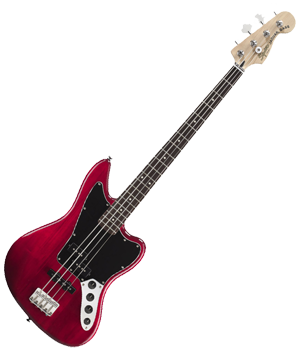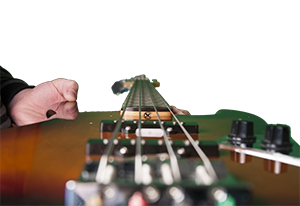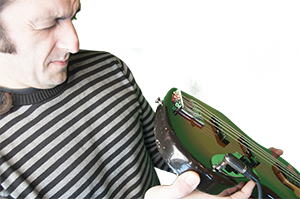Bass
Buy a bass guitar
Do you want to buy a bass? here is all the information to help you make the right choice.
What is a bass?
The bass guitar (simply called bass) is an amplified stringed musical instrument designed according to the same principle as the electric guitar. Since the 1950s, the bass guitar has replaced the double bass in the majority of popular music such as rock and pop. Since the 1970s, the bass guitar has been regularly used as a solo instrument, particularly in jazz fusion.

Description
A bass generally has 4 strings, but can also have 5,6,9 or more (we then speak of ERB, Extended-Range Basses). The instrument consists of a neck and a body made of solid or hollow wood including one or more microphones, potentiometers and a bridge, as on the electric guitar.
Read the article on Bass anatomy.
The neck is usually a scale length of 34 inches (86.34 centimeters), but sometimes longer or shorter. Some basses with a smaller scale length (30 inches or 76.2 cm) are called short scales. This neck supports frets (which delimit the notes, like on the guitar) but there are also models that do not have them (like a double bass) called fretless. The method of attaching the neck (screwed, glued or passing through the body) and the type of wood used for the violin influence the sound.
A bass is considered a “Pillar” in a group due to its rhythmic side with the drums and bass accompaniment with the guitar.
Tuning
The bass guitar is generally tuned an octave lower than a guitar, and in the same way as a double bass, that is to say in fourths. The frequencies are as follows when the reference note is A 440 Hz:
E ; (41,203 Hz)
A ; (55,000 Hz)
D ; (73,416 Hz)
G ; (97,998 Hz)
L’accord de la basse à cinq cordes est généralement Si (ou Do), Mi, La, Ré, Sol (B/C E A D G ; ajout d’une corde grave) ou bien, moins fréquemment, Mi, La, Ré, Sol, Do (E A D G C ; ajout d’une corde aiguë). Les basses à six cordes sont accordées en Si, Mi, La, Ré, Sol, Do (B E A D G C ; ajout d’une corde grave et d’une corde aigüe), en quartes. Les basses à 8 cordes possèdent généralement 4 chœurs (paires de cordes accordées à l’octave), et les rares modèles à 12 cordes ont soit 6 chœurs, soit 4 groupes de 3 cordes formant chacun un accord de quinte (dans ce dernier cas, la corde la plus aiguë du chœur est semblable à une corde de guitare).
History
This instrument was designed, like the electric guitar, to compensate for the lack of power of acoustic instruments required in country, rock’n’roll and jazz music as well as the problem of the size of the double bass. It is one of the rare instruments originally intended to be amplified, and of which acoustic versions only appeared later. However, traditional instruments close to what could be considered an acoustic bass already existed in certain African or Arab countries.
Choose your bass
you have to try several to compare them, to see which one you are most comfortable with.
Pay attention to the weight, it is an instrument that you will carry, using a strap, on your left shoulder (if you are right-handed), right for left-handed people. If it is too heavy it will not be comfortable and it will become unpleasant during long
stage performances.
Of course, we don’t all have the same body shape so don’t trust what anyone tells you, try!!
For a child between 7 and 12 years old (depending on size) you should aim for a ¾ bass, the neck is shorter, the body smaller, lighter and therefore more adapted to the child’s body shape.
You can start playing bass around the age of 7, like all instruments it must be the child’s choice. Don’t hesitate to enroll them in musical awareness courses for 1 or 2 years where they will discover all kinds of instruments.
Test the bass
The amp should be as neutral as possible, with the settings in the middle. On the bass the potentiometers (commonly called knobs) in the middle. To have unequalized sound.
Check that it is not curling: Curling? This is when the string vibrates and comes into contact with the fret, the sound is not clear, it makes a crackling sound.
Play fret by fret at different neck heights.
Height of the strings: the further they are from the neck, the more difficult the bass will be to play, this is also synonymous with poor tuning. In specialized stores, they will be able to make adjustments to optimize the instrument.

Look at the handle, it must be as straight as possible. Do not twist to the left or right. Not bent, the strings should be at the same height across the entire neck.

To do this, place your eye in the perspective of the handle.

Test the electronics, move the knobs in all directions. The jack input, there must not be any play between the tip of the jack and the inside of the socket in the handle. Once inside, the jack should no longer move.

The important thing is to feel comfortable behind your instrument, not to feel its weight, not to be embarrassed.
accessories to provide
Rigid cases, low protected, but bulky and not practical. Mandatory for transport on tour
semi-rigid cover ideal for every day.
first-rate cover: the instrument can be damaged, out of tune, etc.
jack: pay attention to the diameter of the cable, the smaller the diameter the less quality it will be damaged more quickly = interference. Feel that the connections are solid. no need for a long length, 2m will be enough to work at home.
electronic tuner: korg
amp: for home 50 watts for stage 100 watts
desk
bass support
strap, the wider it is, the more comfortable it is
Buy a secondhand bass
There is a very large second-hand market which can allow you to have good equipment cheaper but be careful of obsolescence.
If you want to resell your instrument, use classified ads sites like:
le bon coin
audiofanzine
Zikinf
Social networks
facebook
or your music school.

